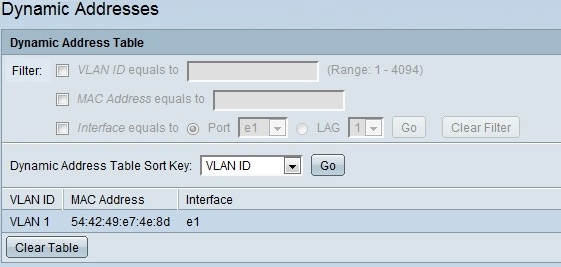

Imagine of you have 20 hosts and switch with 24-ports. I have a switch (SW6), which is connected to other one (SW7) through interfaces Fa0/14 and Fa0/15. The thing is very simple, let me explain to you. Register all MACs in each individual port.įor smaller network, if you do not have authentcation/radius server, you probably can register mac addresses in the switchport, BUT this is a less-preferred solution. Good evening experts, I have an issue with the 'show mac address-table' command. You need to key-in all MACs.Įxtended MAC Access List configuration commands:Įxit Exit from MAC Named ACL configuration mode If you have VLAN, use ACL to filter MAC (without authentication server). following netacad course notes and sending 'show mac address-table' to a switch (in packet tracer) I should get a list of the available MAC addresses.
#CISCO MAC ADDRESS TABLEHISTORY HOW TO#
You can refer to the following links on how to configure 802.1x for access devices:ġ. Cisco No MAC address table shown on Cisco switch cisco packet-tracer switch I'm studying CCNA1. Enable aaa authentication your switch as well. 802.1x uses radius authentication protocol. This will prevent anyone, including visitors to easily gain access to your network.īut to achieve this, you need authentication server like Cisco ACS. User need to use their own user ID & password. With this, any machine connected to your faceplate/network (which is connected to switchport enabled with 802.1x) will get authentication prompt. But you can use feature called 802.1x (switch port authentication) Q: How can I provide access to network with know MAC address list? I have to prevent visitors plugging their laptop into our network.Ī: So far, MAC address suthentication is only available for wireless AP only. You can also configure a static MAC address in interfaceĬonfiguration mode or VLAN configuration mode.Q: Is there any way to get the MAC address of all the end nodes from the switch?Ī: From the switch, issue command 'show arp' or 'show mac-address-table'. You can configure MAC addresses for the switch. Specified number of seconds, it is removed from the address table.Ĭonfiguring MAC Addresses Configuring a Static MAC Address The switch uses an aging mechanism,ĭefined by a configurable aging timer, so if an address remains inactive for a The address table can store a number of unicast and multicast addressĮntries without flooding any frames.

A multicast address can accept more than one interface In addition, you can enter a multicast address as a staticallyĬonfigured MAC address.

These static MAC entries are retained across a reboot You can also enter a MAC address, which is termed a static MACĪddress, into the table. The switch then forwards subsequentįrames to a single LAN port without flooding all LAN ports. The destination station replies, the switch adds its relevant MAC sourceĪddress and port ID to the address table. MAC destination address not listed in its address table, it floods the frame toĪll LAN ports of the same VLAN except the port that received the frame. The switch dynamically builds the address table by using the MAC When the switch receives a frame, it associates the mediaĪccess control (MAC) address of the sending network device with the LAN port on To switch frames between LAN ports efficiently, the switch maintainsĪn address table. This chapter describes the configuration of the MAC address tables.
#CISCO MAC ADDRESS TABLEHISTORY SERIES#
Verifying the MAC Address ConfigurationĪll Ethernet interfaces on Cisco Nexus 5000 Series switches maintain media access control (MAC) address tables.Clearing Dynamic Addresses from the MAC Table.Configuring the Aging Time for the MAC Table.Configuring Fabric Configuration Servers.Advanced Fibre Channel Features and Concepts.Managing FLOGI, Name Server, FDMI, and RSCN Databases.Configuring Fibre Channel Routing Services and Protocols.Configuring FCoE VLANs and Virtual Interfaces.Configuring Authentication, Authorization, and Accounting.Configuring Access and Trunk Interfaces.


 0 kommentar(er)
0 kommentar(er)
